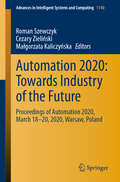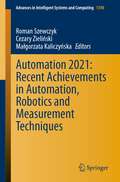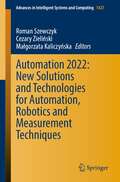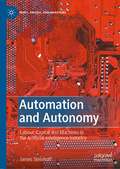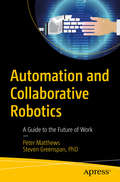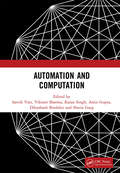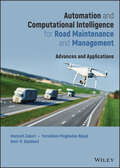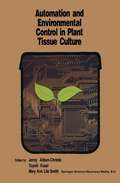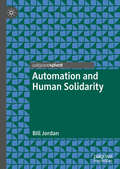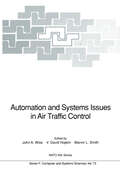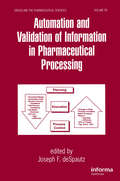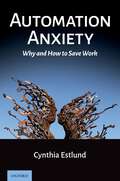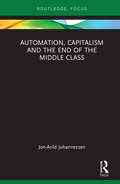- Table View
- List View
Automation 2020: Proceedings of Automation 2020, March 18–20, 2020, Warsaw, Poland (Advances in Intelligent Systems and Computing #1140)
by Roman Szewczyk Cezary Zieliński Małgorzata KaliczyńskaThis book presents the scientific outcomes of the International Conference AUTOMATION 2020, held on March 18–20, 2020 in Warsaw, Poland. The next 30 years will see radical innovations in production processes, transportation management and social life. The changes brought about by the transformation to zero-emission industry require advances in many fields, but especially in industrial automation, robotics and measurement techniques associated with the cyber-physical systems employing artificial intelligence that will be key to reducing costs and enabling European society to maintain its quality of live. In this context, the book features the latest research toward further developing these fields of engineering, and also offers solutions and guidelines that are useful for both researchers and engineers addressing problems associated with the world of ongoing radical changes.
Automation 2021: Recent Achievements in Automation, Robotics and Measurement Techniques (Advances in Intelligent Systems and Computing #1390)
by Roman Szewczyk Cezary Zieliński Małgorzata KaliczyńskaThis book contains 38 papers authored by both scientists and practitioners focused on an interdisciplinary approach to the development of cyber-physical systems. Recently our civilization has been facing one of the most severe challenges in modern history. The COVID-19 pandemic devastated the global economy and significantly disrupted numerous areas of economic activity. Only radical increase of efficiency and versatility of industrial production, with further limitation of human involvement, paralleled by the decrease of environmental burden, will enable us to cope with such challenges. We hope that the presented book provides input to the solution of at least some problems brought about by this challenge. This approach relies on the development of measuring techniques, robotic and mechatronic systems, industrial automation, numerical modeling and simulation as well as application of artificial intelligence techniques required by the transformation leading to Industry 4.0.
Automation 2022: New Solutions and Technologies for Automation, Robotics and Measurement Techniques (Advances in Intelligent Systems and Computing #1427)
by Roman Szewczyk Cezary Zieliński Małgorzata KaliczyńskaThis book presents the unique result of discussion among interdisciplinary specialists facing recent industrial and economic challenges. It contains papers authored by both scientists and practitioners focused on an interdisciplinary approach to developing measuring techniques, robotic and mechatronic systems, industrial automation, numerical modelling and simulation, and application of artificial intelligence techniques required by the transformation leading to Industry 4.0. We strongly believe that the solutions and guidelines presented in this book will be useful to both researchers and engineers facing problems associated with developing cyber-physical systems for global development.
Automation 2023: Key Challenges in Automation, Robotics and Measurement Techniques (Lecture Notes In Networks And Systems Ser. #630)
by Roman Szewczyk Cezary Zieliński Małgorzata Kaliczyńska Vytautas BučinskasAutomation and Autonomy: Labour, Capital and Machines in the Artificial Intelligence Industry (Marx, Engels, and Marxisms)
by James SteinhoffThis book argues that Marxist theory is essential for understanding the contemporary industrialization of the form of artificial intelligence (AI) called machine learning. It includes a political economic history of AI, tracking how it went from a fringe research interest for a handful of scientists in the 1950s to a centerpiece of cybernetic capital fifty years later. It also includes a political economic study of the scale, scope and dynamics of the contemporary AI industry as well as a labour process analysis of commercial machine learning software production, based on interviews with workers and management in AI companies around the world, ranging from tiny startups to giant technology firms. On the basis of this study, Steinhoff develops a Marxist analysis to argue that the popular theory of immaterial labour, which holds that information technologies increase the autonomy of workers from capital, tending towards a post-capitalist economy, does not adequately describe the situation of high-tech digital labour today. In the AI industry, digital labour remains firmly under the control of capital. Steinhoff argues that theories discerning therein an emergent autonomy of labour are in fact witnessing labour’s increasing automation.
Automation and Basic Techniques in Medical Microbiology
by Santi M. Mandal Debarati PaulThis book discusses principles, methodology, and applications of microbiological laboratory techniques . It lays special emphasis on the use of various automated machines that are essential for medical microbiology and diagnostic labs. The book contains eleven major chapters. The first chapter describes the good lab practices which should be followed by the students in all biological, chemistry or microbiology laboratories. The next chapter describes manual and automated characterization of antibiotic resistant microbes, followed by a chapter on genomics based tools and techniques that are integral to research. Further chapters deal with other important techniques like immunology based techniques, spectrophotometry and its various types, MALDI-TOFF and microarrays, each with illustrations and detailed description of the protocols and applications. The book also gives certain important guidelines to the students about the planning the experiment and interpreting results.The book is highly informative and provides latest techniques. It is a handy compendium for graduate and post graduate students, as well as more advanced researchers.
Automation and Collaborative Robotics: A Guide to the Future of Work
by Peter Matthews Steven GreenspanUnderstand the current and future research into technologies that underpin the increasing capabilities of automation technologies and their impact on the working world of the future.Rapid advances in automation and robotics technologies are often reported in the trade and general media, often relying on scary headlines such as “Jobs Lost to Robots.” It is certainly true that work will change with the advent of smarter and faster automated workers; however, the scope and scale of the changes is still unknown. Automation may seem to be here already, but we are only at the early stages. Automation and Collaborative Robotics explores the output of current research projects that are improving the building blocks of an automated world. Research into collaborative robotics (cobotics) is merging digital, audio, and visual data to generate a commonly held view between cobots and their human collaborators. Low-power machine learning at the edge of the network can deliver decision making on cobots or to their manipulations. Topics covered in this book include: Robotic process automation, chatbots, and their impact in the near futureThe hype of automation and headlines leading to concerns over the future of workComponent technologies that are still in the research labsFoundational technologies and collaboration that will enable many tasks to be automated with human workers being re-skilled and displaced rather than replaced What You Will Learn Be aware of the technologies currently being researched to improve or deliver automationUnderstand the impact of robotics, other automation technologies, and the impact of AI on automationGet an idea of how far we are from implementation of an automated futureKnow what work will look like in the future with the deployment of these technologies Who This Book Is For Technical and business managers interested in the future of automation and robotics, and the impact it will have on their organizations, customers, and the business world in general
Automation and Computation: Proceedings of the International Conference on Automation and Computation, (AutoCom 2022), Dehradun, India
by Satvik Vats Vikrant Sharma Karan Singh Amit Gupta Dibyahash Bordoloi Navin GargThe proceedings of the International Conference on Automation and Computation 2022 (AUTOCOM-22) consist of complete research articles that were presented at the conference. Each of the research articles was double-blind reviewed by the experts of the corresponding domain. The book contains a blend of problems and respective solutions related to computer-based automation & computation to highlight the recent technological developments in computer-based automation. It serves as an environment for researchers to showcase the latest research results on Data Science & Engineering, Computing Technologies, Computational Intelligence, Communication & Networking, Signal & Image Processing, Intelligent Control Systems & Optimization, Robotics and Automation, Power, Energy & Power Electronics, Healthcare & Computation, AI for human interaction, etc. It aims to give deep insight into the current trends of research in science and technology and shall introduce the reader to the new problems and respective approaches toward the solution and shall enlighten the researchers, students and academicians about the research being carried out in the field.
Automation and Computation: Proceedings of the International Conference on Automation and Computation, (AutoCom 2022), Dehradun, India
by Satvik Vats Sharma Vikrant Karan Singh Amit Gupta Dibyahash Bordoloi Navin GargThe proceedings of the International Conference on Automation and Computation 2022 (AUTOCOM-22) consist of complete research articles that were presented at the conference. Each of the research articles was double-blind reviewed by the experts of the corresponding domain. The book contains a blend of problems and respective solutions related to computer-based automation & computation to highlight the recent technological developments in computer-based automation. It serves as an environment for researchers to showcase the latest research results on Data Science & Engineering, Computing Technologies, Computational Intelligence, Communication & Networking, Signal & Image Processing, Intelligent Control Systems & Optimization, Robotics and Automation, Power, Energy & Power Electronics, Healthcare & Computation, AI for human interaction, etc. It aims to give deep insight into the current trends of research in science and technology and shall introduce the reader to the new problems and respective approaches toward the solution and shall enlighten the researchers, students and academicians about the research being carried out in the field.
Automation and Computational Intelligence for Road Maintenance and Management: Advances and Applications
by Hamzeh Zakeri Fereidoon Moghadas Nejad Amir H. GandomiAutomation and Computational Intelligence for Road Maintenance and Management A comprehensive computational intelligence toolbox for solving problems in infrastructure management In Automation and Computational Intelligence for Road Maintenance and Management, a team of accomplished researchers delivers an incisive reference that covers the latest developments in computer technology infrastructure management. The book contains an overview of foundational and emerging technologies and methods in both automation and computational intelligence, as well as detailed presentations of specific methodologies. The distinguished authors emphasize the most recent advances in the maintenance and management of infrastructure robotics, automated inspection, remote sensing, and the applications of new and emerging computing technologies, including artificial intelligence, evolutionary computing, fuzzy logic, genetic algorithms, knowledge discovery and engineering, and more. Automation and Computational Intelligence for Road Maintenance and Management explores a universal synthesis of the cutting edge in parameters and indices to evaluate models. It also includes: Thorough introductions to management science and the latest methods of automation and the structure and framework of automation and computing intelligence Comprehensive explorations of advanced image processing techniques, recent advances in fuzzy, and diagnosis automation Practical discussions of segmentation and fragmentation and different types of features and feature extraction methods In-depth examinations of methods of classification along with various developed methodologies and models of quantification, evaluation, and indexing in automation Perfect for postgraduate students in road and transportation engineering, evaluation, and assessment, Automation and Computational Intelligence for Road Maintenance and Management will also earn a place in the libraries of researchers interested in or working with the evaluation and assessment of infrastructure.
Automation and Computational Intelligence for Road Maintenance and Management: Advances and Applications
by Hamzeh Zakeri Fereidoon Moghadas Nejad Amir H. GandomiAutomation and Computational Intelligence for Road Maintenance and Management A comprehensive computational intelligence toolbox for solving problems in infrastructure management In Automation and Computational Intelligence for Road Maintenance and Management, a team of accomplished researchers delivers an incisive reference that covers the latest developments in computer technology infrastructure management. The book contains an overview of foundational and emerging technologies and methods in both automation and computational intelligence, as well as detailed presentations of specific methodologies. The distinguished authors emphasize the most recent advances in the maintenance and management of infrastructure robotics, automated inspection, remote sensing, and the applications of new and emerging computing technologies, including artificial intelligence, evolutionary computing, fuzzy logic, genetic algorithms, knowledge discovery and engineering, and more. Automation and Computational Intelligence for Road Maintenance and Management explores a universal synthesis of the cutting edge in parameters and indices to evaluate models. It also includes: Thorough introductions to management science and the latest methods of automation and the structure and framework of automation and computing intelligence Comprehensive explorations of advanced image processing techniques, recent advances in fuzzy, and diagnosis automation Practical discussions of segmentation and fragmentation and different types of features and feature extraction methods In-depth examinations of methods of classification along with various developed methodologies and models of quantification, evaluation, and indexing in automation Perfect for postgraduate students in road and transportation engineering, evaluation, and assessment, Automation and Computational Intelligence for Road Maintenance and Management will also earn a place in the libraries of researchers interested in or working with the evaluation and assessment of infrastructure.
Automation and environmental control in plant tissue culture
by Jenny Aitken-Christie T. Kozai M. A. L SmithAutomation and Environmental Control in Plant Tissue Culture rigorously explores the new challenges faced by modern plant tissue culture researchers and producers worldwide: issues of cost efficiency, automation, control, and optimization of the in vitro microenvironment. This book achieves a critical balance between the economic, engineering and biological viewpoints, and presents well-balanced, unique, and clearly organized perspectives on current initiatives in the tissue culture arena. Each chapter offers guidelines leading towards an exhaustive, unprecedented level of control over in vitro growth, based on emerging technologies of robotics, machine vision, environmental sensors and regulation, and systems analysis. Unlike other tissue culture books which focus on specific crops and techniques, this book spans the broad range of major tissue culture production systems, and advances evidence on how some underrated aspects of the process actually determine the status of the end product. Key researchers from industry and academia have joined to give up-to-date research evidence and analysis. The collection comprises an essential reference for industrial-scale tissue culture producers, as well as any researcher interested in optimizing in vitro production.
Automation and Human Performance: Theory and Applications
by Raja Parasuraman Mustapha MoulouaThere is perhaps no facet of modern society where the influence of computer automation has not been felt. Flight management systems for pilots, diagnostic and surgical aids for physicians, navigational displays for drivers, and decision-aiding systems for air-traffic controllers, represent only a few of the numerous domains in which powerful new automation technologies have been introduced. The benefits that have been reaped from this technological revolution have been many. At the same time, automation has not always worked as planned by designers, and many problems have arisen--from minor inefficiencies of operation to large-scale, catastrophic accidents. Understanding how humans interact with automation is vital for the successful design of new automated systems that are both safe and efficient. The influence of automation technology on human performance has often been investigated in a fragmentary, isolated manner, with investigators conducting disconnected studies in different domains. There has been little contact between these endeavors, although principles gleaned from one domain may have implications for another. Also, with a few exceptions, the research has tended to be empirical and only theory-driven. In recent years, however, various groups of investigators have begun to examine human performance in automated systems in general and to develop theories of human interaction with automation technology. This book presents the current theories and assesses the impact of automation on different aspects of human performance. Both basic and applied research is presented to highlight the general principles of human-computer interaction in several domains where automation technologies are widely implemented. The major premise is that a broad-based, theory-driven approach will have significant implications for the effective design of both current and future automation technologies. This volume will be of considerable value to researchers in human
Automation and Human Performance: Theory and Applications (Human Factors In Transportation Ser.)
by Raja Parasuraman and Mustapha MoulouaThere is perhaps no facet of modern society where the influence of computer automation has not been felt. Flight management systems for pilots, diagnostic and surgical aids for physicians, navigational displays for drivers, and decision-aiding systems for air-traffic controllers, represent only a few of the numerous domains in which powerful new automation technologies have been introduced. The benefits that have been reaped from this technological revolution have been many. At the same time, automation has not always worked as planned by designers, and many problems have arisen--from minor inefficiencies of operation to large-scale, catastrophic accidents. Understanding how humans interact with automation is vital for the successful design of new automated systems that are both safe and efficient. The influence of automation technology on human performance has often been investigated in a fragmentary, isolated manner, with investigators conducting disconnected studies in different domains. There has been little contact between these endeavors, although principles gleaned from one domain may have implications for another. Also, with a few exceptions, the research has tended to be empirical and only theory-driven. In recent years, however, various groups of investigators have begun to examine human performance in automated systems in general and to develop theories of human interaction with automation technology. This book presents the current theories and assesses the impact of automation on different aspects of human performance. Both basic and applied research is presented to highlight the general principles of human-computer interaction in several domains where automation technologies are widely implemented. The major premise is that a broad-based, theory-driven approach will have significant implications for the effective design of both current and future automation technologies. This volume will be of considerable value to researchers in human
Automation and Human Solidarity
by Bill JordanThis book provides a detailed analysis of the economic and political implications of the introduction of Artificial Intelligence and Robotics into the service sector of economies that have so far relied on service jobs to sustain levels of employment. It examines how reliance on coercive measures for enforcing low-paid service work attempts to postpone this third Industrial Revolution, and analyses the struggles that must still take place if we are to achieve a future of freedom and social justice for all. While automation and globalisation have made human solidarities of traditional kinds more difficult to sustain, they have also made new kinds possible. Experiments in social policy, and especially the pilot projects with unconditional Universal Basic Incomes, offer a possible model for a new kind of society. The author argues that it is politics which will determine whether we can achieve these new human solidarities.
Automation and Innovation with Computational Techniques for Futuristic Smart, Safe and Sustainable Manufacturing Processes
by Arturo Realyvásquez Vargas Suchismita Satapathy Jorge Luis García AlcarazThis book explores sustainability and innovation in manufacturing, encompassing three distinct parts. The first section delves into Sustainability in Manufacturing, where it analyzes topics like intelligent manufacturing, Industry 4.0 challenges, structural equation modeling for social sustainability, barriers to intelligent manufacturing systems, and critical success factors in Six Sigma deployment. The second part of the book, comprising Chapters 6-11, focuses on Ergonomics and Safety in manufacturing, examining cases related to health issues caused by factors like noise, high-temperature working conditions, ergonomic posture, and design attributes for ergonomic products. Lastly, Part III, consisting of Chapters 12-14, explores computational techniques applied in manufacturing, addressing issues such as vegetable waste in India, technology transfer models for university-industry collaboration, and the application of System Dynamics in safety management systems. Together, these chapters provide a comprehensive overview of sustainability, ergonomics, safety, and computational techniques in the manufacturing industry.
Automation and Its Macroeconomic Consequences: Theory, Evidence, and Social Impacts
by Klaus Prettner David E. BloomAutomation and Its Macroeconomic Consequences reveals new ways to understand the economic characteristics of our increasing dependence on machines. Illuminating technical and social elements, it describes economic policies that could counteract negative income distribution consequences of automation without hampering the adoption of new technologies. Arguing that modern automation cannot be compared to the Industrial Revolution, it considers consequences of automation such as spatial patterns, urbanization, and regional concerns. In touching upon labor, growth, demographic, and policy, Automation and its Macroeconomic Consequences stands at the intersection of technology and economics, offering a comprehensive portrait illustrated by empirical observations and examples. - Introduces formal growth models that include automation and the empirical specifications on which the data-driven results rely - Focuses on formal modeling, empirical analysis and derivation of evidence-based policy conclusions - Considers consequences of automation, such as spatial patterns, urbanization and regional concerns
Automation and Robotics in the Architecture, Engineering, and Construction Industry
by Somayeh Asadi Houtan Jebelli Mahmoud Habibnezhad Shayan Shayesteh SangHyun LeeAutomation and Robotics in the Architecture, Engineering, and Construction Industry provides distinct and unified insight into current and future construction robotics, offering readers a comprehensive perspective for constructing a road map and illuminating improvements for a successful transition towards construction robotization. The book covers the fundamentals and applications of robotics, autonomous vehicles, and human-perceptive machines at construction sites. Through theoretical and experimental analyses, it examines the potential of robotics and automated systems for current and future fieldwork operations and identifies the factors that determine their implementation pace, adoption scale, and ubiquity throughout the industry. The book evaluates the technical, societal, and economic aspects of adopting robots in construction, both as standalone and collaborative systems, which in return can afford the opportunity to investigate these AI-enabled machines more systematically.
Automation and Systems Issues in Air Traffic Control (NATO ASI Subseries F: #73)
by John A. Wise V. David Hopkin Marvin L. SmithIn recent years, increases in the amount and changes in the distribution of air traffic have been very dramatic and are continuing. The need for changes in the current air traffic systems is equally clear. While automation is generally accepted as a method of improving system safety and performance, high levels of automation in complex human-machine systems can have a negative effect on total system performance and have been identified as contributing factors in many accidents and failures. Those responsible for designing the advanced air traffic control systems to be implemented throughout the alliance during the next decade need to be aware of recent progress concerning the most effective application of automation and artificial intelligence in human-computer systems. This volume gives the proceedings of the NATO Advanced Study Institute held in Maratea, Italy, June 18-29, 1990, at which these issues were discussed.
Automation and Utopia: Human Flourishing in a World without Work
by John DanaherAutomating technologies threaten to usher in a workless future, but John Danaher argues that this can be a good thing. A world without work may be a kind of utopia, free of the misery of the job and full of opportunities for creativity and exploration. If we play our cards right, automation could be the path to idealized forms of human flourishing.
Automation and Validation of Information in Pharmaceutical Processing
by Joseph F. deSpautzThis thoroughly authoritative work furnishes organizational, technological, validation, project management, and business perspectives on pharmaceutical information automation from industry and system automation professionals-demonstrating how to fulfill computer system validation requirements for hardware, applications, networks, data center operat
Automation and World Competition: New Technologies, Industrial Location and Trade
by Ashoka Mody David WheelerThis book analyses the dynamics of international production location and trade. These dynamics are being driven by new technologies (such as microelectronics) and the independent emergence of large low-wage countries such as China.
Automation Anxiety: Why and How to Save Work
by Cynthia EstlundAre super-capable robots and algorithms destined to devour our jobs and idle much of the adult population? Predictions of a jobless future have recurred in waves since the advent of industrialization, only to crest and retreat as new jobs-usually better ones-have replaced those lost to machines. But there's good reason to believe that this time is different. Ongoing innovations in artificial intelligence, machine learning, and robotics are already destroying more decent middle-skill jobs than they are creating, and may be leading to a future of growing job scarcity. But there are many possible versions of that future, ranging from utterly dystopian to humane and broadly appealing. It all depends on how we respond. This book confronts the hotly-debated prospect of mounting job losses due to automation, and the widely-divergent hopes and fears that prospect evokes, and proposes a strategy for both mitigating the losses and spreading the gains from shrinking demand for human labor. We should set our collective sights, it argues, on ensuring access to adequate incomes, more free time, and decent remunerative work even in a future with less of it. Getting there will require not a single "magic bullet" solution like universal basic income or a federal job guarantee but a multi-pronged program centered on conserving, creating, and spreading work. What the book proposes for a foreseeable future of less work will simultaneously help to address growing economic inequality and persistent racial stratification, and makes sense here and now but especially as we face the prospect of net job losses.
Automation Anxiety: Why and How to Save Work
by Cynthia EstlundAre super-capable robots and algorithms destined to devour our jobs and idle much of the adult population? Predictions of a jobless future have recurred in waves since the advent of industrialization, only to crest and retreat as new jobs-usually better ones-have replaced those lost to machines. But there's good reason to believe that this time is different. Ongoing innovations in artificial intelligence, machine learning, and robotics are already destroying more decent middle-skill jobs than they are creating, and may be leading to a future of growing job scarcity. But there are many possible versions of that future, ranging from utterly dystopian to humane and broadly appealing. It all depends on how we respond. This book confronts the hotly-debated prospect of mounting job losses due to automation, and the widely-divergent hopes and fears that prospect evokes, and proposes a strategy for both mitigating the losses and spreading the gains from shrinking demand for human labor. We should set our collective sights, it argues, on ensuring access to adequate incomes, more free time, and decent remunerative work even in a future with less of it. Getting there will require not a single "magic bullet" solution like universal basic income or a federal job guarantee but a multi-pronged program centered on conserving, creating, and spreading work. What the book proposes for a foreseeable future of less work will simultaneously help to address growing economic inequality and persistent racial stratification, and makes sense here and now but especially as we face the prospect of net job losses.
Automation, Capitalism and the End of the Middle Class (Routledge Focus on Economics and Finance)
by Jon-Arild JohannessenIn this book, the author argues that a new form of capitalism is emerging at the threshold of the Fourth Industrial Revolution. He asserts that we are in the midst of a transition from democratic capitalism to feudal capitalism and highlights how robotization and innovation is leading to a social crisis for the middle classes as economic inequality is on the rise. Johannessen outlines the three elements – Balkanization, the Great Illusion, and the plutocracy – which are referred to here as feudal structures. He describes, analyzes, and discusses these elements both individually and in interaction with each other, and asks: "What structures and processes are promoting and boosting feudal capitalism?" Additionally, the book serves to generate knowledge about how the middle class will develop in the Fourth Industrial Revolution. It shows the various effects of robotization on the middle class, where middle class jobs are transformed, deconstructed, and re-constructed and new part-time jobs are created for the middle class. Given the interest in the Fourth Industrial Revolution, the book will appeal to students of economic sociology and political economy as well as those in innovation and knowledge management courses focusing upon the emerging innovation economy. The topic will attract policymakers, and the accessible and engaging tone will also make the book of interest to the general public.
